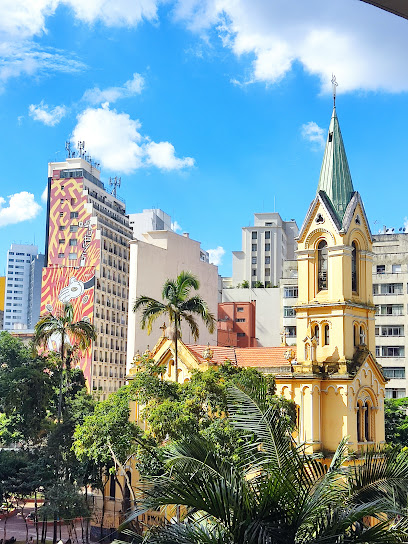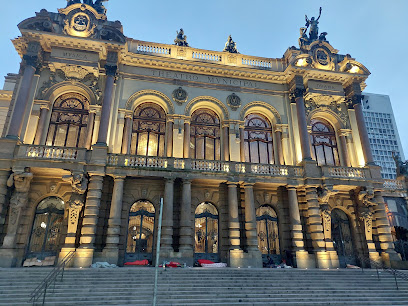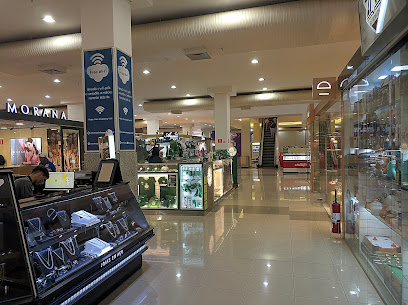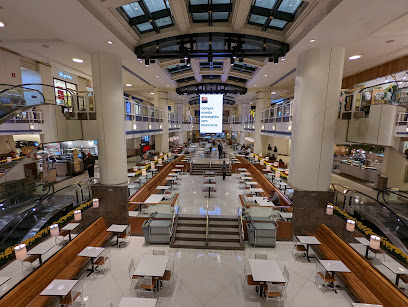
São Paulo: A Vibrant Metropolis of Culture and Diversity
Discover São Paulo, Brazil’s largest city, where cultural diversity, culinary delights, and vibrant neighborhoods create an unforgettable urban experience.
São Paulo, often referred to as Sampa by locals, is Brazil's largest city and a bustling hub of culture, art, and gastronomy. This sprawling metropolis is known for its skyscraper-filled skyline, vibrant neighborhoods, and a rich mosaic of cultural influences from around the world. Whether you're a history buff, a foodie, or an art lover, São Paulo has something to offer everyone. A visit to São Paulo is incomplete without exploring its diverse neighborhoods. Start your journey in the historic center, where you'll find iconic landmarks like the São Paulo Cathedral and the Municipal Market. Wander through the bohemian district of Vila Madalena, famous for its colorful street art and eclectic bars. Don't miss the upscale Jardins area, home to high-end boutiques and gourmet restaurants. São Paulo is also a city of green spaces and cultural institutions. Take a leisurely stroll through Ibirapuera Park, an oasis of tranquility in the heart of the city, and visit the renowned Museum of Art of São Paulo (MASP), which boasts an impressive collection of Western art. For a taste of the city's vibrant nightlife, head to the Vila Olímpia district, known for its lively clubs and music venues. Food lovers will be in heaven in São Paulo, a city that prides itself on its culinary diversity. From traditional Brazilian dishes to international cuisine, the city's dining scene is a reflection of its multicultural population. Be sure to try the famous Brazilian barbecue, feijoada (a hearty black bean stew), and pastel (deep-fried pastry filled with various ingredients) during your stay.
Local tips in São Paulo
- Use the Metro for convenient and efficient travel, especially during peak hours.
- Visit on a Sunday to enjoy Paulista Avenue closed to traffic, transforming into a pedestrian-friendly space.
- Learn a few basic Portuguese phrases; English is not widely spoken.
- Keep an eye on your belongings in crowded areas to avoid pickpocketing.
- Try the local street food, especially in markets like Mercadão.
- Check out local cultural events and festivals; São Paulo always has something happening.
Neighbourhoods in São Paulo
São Paulo: A Vibrant Metropolis of Culture and Diversity
São Paulo, often referred to as Sampa by locals, is Brazil's largest city and a bustling hub of culture, art, and gastronomy. This sprawling metropolis is known for its skyscraper-filled skyline, vibrant neighborhoods, and a rich mosaic of cultural influences from around the world. Whether you're a history buff, a foodie, or an art lover, São Paulo has something to offer everyone. A visit to São Paulo is incomplete without exploring its diverse neighborhoods. Start your journey in the historic center, where you'll find iconic landmarks like the São Paulo Cathedral and the Municipal Market. Wander through the bohemian district of Vila Madalena, famous for its colorful street art and eclectic bars. Don't miss the upscale Jardins area, home to high-end boutiques and gourmet restaurants. São Paulo is also a city of green spaces and cultural institutions. Take a leisurely stroll through Ibirapuera Park, an oasis of tranquility in the heart of the city, and visit the renowned Museum of Art of São Paulo (MASP), which boasts an impressive collection of Western art. For a taste of the city's vibrant nightlife, head to the Vila Olímpia district, known for its lively clubs and music venues. Food lovers will be in heaven in São Paulo, a city that prides itself on its culinary diversity. From traditional Brazilian dishes to international cuisine, the city's dining scene is a reflection of its multicultural population. Be sure to try the famous Brazilian barbecue, feijoada (a hearty black bean stew), and pastel (deep-fried pastry filled with various ingredients) during your stay.
When is the best time to go to São Paulo?
Iconic landmarks you can’t miss
Ibirapuera Park
Explore the lush landscapes, cultural attractions, and recreational activities at Ibirapuera Park in São Paulo, a vibrant urban oasis for relaxation and adventure.

Mercado Municipal de São Paulo
Explore the vibrant Mercado Municipal de São Paulo, a bustling market filled with local flavors, fresh produce, and cultural experiences in the heart of Brazil's largest city.

Museum of Art of São Paulo Assis Chateaubriand
Discover the rich artistic heritage at the Museum of Art of São Paulo, a must-visit destination for art lovers and cultural enthusiasts.

Galeria do Rock
Experience the eclectic mix of shopping, music, and culture at Galeria do Rock in São Paulo, a vibrant hub for creative expression and urban life.

Teatro Municipal de São Paulo
Explore the grandeur of Teatro Municipal de São Paulo, a cultural landmark showcasing world-class performances and stunning architecture in the heart of the city.

Beco do Batman
Discover the colorful murals of Beco do Batman, São Paulo's open-air museum showcasing captivating street art and vibrant local culture.

Centro Cultural Banco do Brasil São Paulo
Explore the vibrant world of art and culture at Centro Cultural Banco do Brasil São Paulo, where history meets contemporary creativity in a stunning setting.

Catedral Metropolitana de São Paulo (da Sé)
Experience the grandeur of São Paulo's Catedral Metropolitana, a neo-Gothic masterpiece and cultural landmark in the heart of the city.

Farol Santander
Explore the historic Farol Santander, a captivating museum in São Paulo with stunning views, diverse art exhibitions, and rich cultural experiences.

Franklin Roosevelt Square
Explore the vibrant Franklin Roosevelt Square in São Paulo - a cultural hub filled with art, food, and lively events for every traveler.

Mosteiro de São Bento
Experience the architectural beauty and spiritual tranquility of Mosteiro de São Bento in São Paulo’s historic center, a must-visit for travelers.

Altino Arantes Building
Experience the breathtaking views and architectural beauty of the Altino Arantes Building in São Paulo, a must-visit tourist attraction.

Monument to the Independence of Brazil
Explore the Monument to the Independence of Brazil in São Paulo, a remarkable tribute to freedom and a symbol of Brazil's rich history.

Marco Zero de São Paulo
Experience the cultural heartbeat of São Paulo at Marco Zero, the city's historic landmark and starting point for Brazilian exploration.

Largo do Arouche
Explore the vibrant Largo do Arouche, a cultural hub in São Paulo, where history meets modernity amidst lively street life and delicious local cuisine.

Unmissable attractions to see
Ibirapuera Park
Experience the breathtaking blend of nature, culture, and recreation at Ibirapuera Park, São Paulo's premier urban oasis.

Mercado Municipal Paulistano
Discover the flavors of São Paulo at Mercado Municipal Paulistano, a vibrant market filled with fresh produce, local delicacies, and culinary delights.

Museum of Art of São Paulo Assis Chateaubriand
Discover the rich art heritage at the Museum of Art of São Paulo, featuring iconic works and a stunning architectural design in the heart of the city.

Parque Villa-Lobos
Explore the beauty and culture of Parque Villa-Lobos, São Paulo's premier state park, offering lush landscapes, recreational activities, and cultural events for all.

Allianz Parque
Experience the thrill of Brazilian soccer at Allianz Parque, São Paulo's premier stadium and cultural landmark, home to the legendary Palmeiras.

Neo Química Arena
Discover the vibrant atmosphere of Neo Química Arena, São Paulo's premier stadium for sports and entertainment, uniting fans and visitors in unforgettable experiences.

MorumBIS
Explore MorumBIS, São Paulo's iconic stadium, where football passion and Brazilian culture converge in a vibrant atmosphere.

São Paulo Expo
Experience the heart of innovation and culture at São Paulo Expo, the premier event venue in Brazil, showcasing global exhibitions and dynamic events.

Memorial da América Latina
Explore the rich culture of Latin America at Memorial da América Latina, a vibrant center for art, exhibitions, and community events in São Paulo.

Parque da Independência
Discover the lush landscapes and historical significance of Parque da Independência, a must-visit urban oasis in São Paulo.

Aquário de São Paulo
Experience the wonders of marine life at Aquário de São Paulo, an engaging aquarium showcasing diverse aquatic species and conservation efforts.

Parque da Água Branca
Explore São Paulo's Parque da Água Branca, a serene urban park featuring lush gardens, cultural events, and fun activities for the entire family.

Anhembi Sambadrome
Experience the vibrant spirit of Brazil at Anhembi Sambadrome, home to spectacular Carnival parades and cultural events in São Paulo.

Pinacoteca de São Paulo
Discover the artistic soul of Brazil at the Pinacoteca de São Paulo, featuring masterpieces from the 19th century to contemporary art in a stunning setting.

Museu Catavento
Explore Museu Catavento in São Paulo, an interactive science museum offering engaging exhibits and educational experiences for all ages.

Essential places to dine
Coco Bambu
Discover the ultimate seafood experience at Coco Bambu in São Paulo, where every dish is a tribute to Brazil's rich maritime flavors.

A Casa do Porco Bar
Discover the vibrant flavors of Brazil at A Casa do Porco Bar in São Paulo - where meat lovers find culinary delights in every bite.

Terraço Itália
Experience exquisite Italian dining with breathtaking views at Terraço Itália, São Paulo's premier culinary destination in the sky.

Jiquitaia
Experience the essence of Brazilian cuisine at Jiquitaia in São Paulo - where tradition meets contemporary dining.

Evvai Restaurant
Discover Evvai Restaurant: An upscale Italian dining experience in São Paulo’s Pinheiros neighborhood offering innovative dishes and refined ambiance.

Empório Cantina Roperto
Experience authentic Italian cuisine at Empório Cantina Roperto in São Paulo's Bela Vista – where every meal is a celebration of flavor.

D.O.M.
Experience innovative Brazilian cuisine at D.O.M., where Chef Alex Atala crafts unforgettable dishes celebrating Brazil's rich biodiversity.

Nou Restaurante
Experience the best of Brazilian cuisine at Nou Restaurante in Pinheiros, São Paulo - where fresh salads meet exquisite seafood.

Lazzarella
Experience authentic Italian cuisine at Lazzarella in São Paulo's Bela Vista – where every meal is crafted with passion and tradition.

Tordesilhas
Experience authentic Brazilian cuisine at Tordesilhas in São Paulo, where every dish tells a story of Brazil's rich culinary heritage.

Restaurante Capim Santo São Paulo
Explore the vibrant flavors of Brazil at Restaurante Capim Santo in São Paulo—where health meets exquisite taste.

Esther Rooftop
Experience exquisite modern French cuisine with breathtaking views at Esther Rooftop in São Paulo.

Seen - Restaurant & Bar
Experience luxurious dining at Seen - Restaurant & Bar in São Paulo, featuring exquisite sushi and stunning city views.

Jamile
Experience the vibrant flavors of Brazil at Jamile, where eclectic cuisine meets exceptional service in the heart of São Paulo.

Banzeiro Restaurant - São Paulo
Experience the essence of Brazilian cuisine at Banzeiro Restaurant in São Paulo, where tradition meets innovation in every dish.

Markets, malls and hidden boutiques
Mercado Municipal de São Paulo
Explore the Mercado Municipal de São Paulo, a culinary paradise offering fresh produce and delightful local dishes in a historic market setting.

Shopping Eldorado
Explore Shopping Eldorado in São Paulo, a vibrant shopping mall with diverse stores, delicious dining, and family-friendly entertainment.

Shopping Center Norte
Discover Shopping Center Norte, São Paulo's vibrant shopping mall filled with diverse stores, dining options, and family-friendly entertainment.

Galeria do Rock
Discover the heart of São Paulo's music and art scene at Galeria do Rock, a cultural shopping mall with unique stores and vibrant events.

Shopping Cidade São Paulo
Explore Shopping Cidade São Paulo, a vibrant shopping mall offering diverse stores, delicious dining, and entertainment in the heart of São Paulo.

Morumbi Shopping
Discover the vibrant shopping, dining, and entertainment experiences at Morumbi Shopping in São Paulo, a top destination for tourists and locals alike.

Shopping Ibirapuera
Discover Shopping Ibirapuera, São Paulo's vibrant shopping mall with luxury brands, delightful dining, and endless entertainment options for every visitor.

Pátio Paulista Mall
Explore Pátio Paulista Mall, São Paulo's vibrant shopping destination with top brands, diverse dining, and entertainment for all.

Shopping Metro Santa Cruz
Experience the best of shopping, dining, and entertainment at Shopping Metro Santa Cruz in São Paulo, Brazil.

Shopping Center 3
Experience the vibrant shopping and dining atmosphere at Shopping Center 3, a must-visit destination in the heart of São Paulo.

Mais Shopping
Explore Mais Shopping in São Paulo, where shopping, dining, and entertainment come together for an unforgettable experience.

Shopping Pátio Higienópolis
Discover an exquisite shopping experience at Shopping Pátio Higienópolis, where luxury meets leisure in São Paulo's vibrant retail scene.

Iguatemi Shopping
Explore the luxurious Iguatemi Shopping in São Paulo, where shopping meets exquisite dining and vibrant entertainment options.

Frei Caneca Mall
Explore Frei Caneca Mall, a vibrant shopping hub in São Paulo offering diverse retail, dining, and entertainment experiences for every visitor.

Santana Parque Shopping
Experience the best shopping, dining, and entertainment at Santana Parque Shopping in São Paulo, a vibrant hub for tourists and locals alike.

Essential bars & hidden hideouts
Bar Brahma
Experience the vibrant heart of São Paulo at Bar Brahma, where exceptional cocktails meet authentic Brazilian cuisine in a lively atmosphere.

O'Malley's
Discover the charm of O'Malley's, an inviting Irish pub in São Paulo's Jardim Paulista, with authentic cuisine, vibrant drinks, and an unforgettable atmosphere.

The Blue Pub
Discover the vibrant culture of São Paulo at The Blue Pub, a premier gastropub offering unique dishes, craft drinks, and live entertainment.

Skye
Experience the culinary delights of Skye, a rooftop restaurant in São Paulo offering stunning views and exquisite dishes for an unforgettable dining adventure.

Olívio Bar & Gastronomy
Experience the vibrant flavors of Brazil at Olívio Bar & Gastronomy, where exceptional cuisine meets a lively atmosphere in the heart of São Paulo.

Riviera Bar
Experience the vibrant nightlife at Riviera Bar, São Paulo's premier cocktail destination, where innovative drinks meet a chic atmosphere.

Bar dos Arcos
Experience the essence of São Paulo nightlife at Bar dos Arcos, where exquisite cocktails and a vibrant atmosphere await you.

Bar Original
Discover the vibrant nightlife at Bar Original in Moema, São Paulo – a perfect blend of delicious Brazilian cuisine and lively atmosphere.

Republic English Pub
Experience the best of British pub culture in the heart of São Paulo at Republic English Pub, where food, drinks, and live entertainment meet.

High Line Bar
Discover the vibrant nightlife at High Line Bar in Vila Madalena, São Paulo, where eclectic cocktails and a lively atmosphere await.

Café Piu Piu
Discover the lively atmosphere of Café Piu Piu, a premier live music bar in São Paulo blending exquisite cocktails and unforgettable performances.

Guarita Bar
Discover the vibrant nightlife at Guarita Bar in São Paulo's Pinheiros neighborhood, where eclectic drinks and lively music create an unforgettable experience.

Sky Hall Terrace Bar
Experience the vibrant nightlife of São Paulo at Sky Hall Terrace Bar, where stunning views and exquisite tastes await every visitor.

Drosophyla
Experience the vibrant nightlife of São Paulo at Drosophyla, where creative cocktails and a chic atmosphere await.

Bar Nelson
Experience the vibrant nightlife at Bar Nelson in São Paulo with live music, delicious cocktails, and an inviting atmosphere for all.

Local Phrases
-
- HelloOlá
[oh-lah] - GoodbyeTchau
[chow] - YesSim
[seem] - NoNão
[now] - Please/You're welcomePor favor/De nada
[pohr fah-vohr/deh nah-dah] - Thank youObrigado/Obrigada
[oh-bree-gah-doh/oh-bree-gah-dah] - Excuse me/SorryCom licença/Desculpe
[kohm lee-sen-sah/dehs-kool-peh] - How are you?Como vai?
[koh-moh vah-ee] - Fine. And you?Bem. E você?
[behn/eh voh-seh] - Do you speak English?Você fala inglês?
[voh-seh fah-lah een-glehz] - I don't understandEu não entendo
[eh-oo now en-ten-doh]
- HelloOlá
-
- I'd like to see the menu, pleaseEu gostaria de ver o cardápio, por favor
[eh-oo goh-stah-ree-ah deh vehr oo cahr-dah-pee-oh, pohr fah-vohr] - I don't eat meatEu não como carne
[eh-oo now koh-moh kahr-neh] - Cheers!Saúde!
[sow-djee] - I would like to pay, pleaseEu gostaria de pagar, por favor
[eh-oo goh-stah-ree-ah deh pah-gahr, pohr fah-vohr]
- I'd like to see the menu, pleaseEu gostaria de ver o cardápio, por favor
-
- Help!Socorro!
[soh-koh-roh] - Go away!Vá embora!
[vah ehm-boh-rah] - Call the Police!Chame a polícia!
[shah-mee ah poh-lee-see-ah] - Call a doctor!Chame um médico!
[shah-mee oom meh-dee-koo] - I'm lostEstou perdido
[ehs-toh pehr-dee-doh] - I'm illEstou doente
[ehs-toh doh-ehn-chee]
- Help!Socorro!
-
- I'd like to buy...Eu gostaria de comprar...
[eh-oo goh-stah-ree-ah deh kohm-prahr] - I'm just lookingEu só estou olhando
[eh-oo sow eh-stoh oh-lahn-doh] - How much is it?Quanto custa?
[kwahn-toh kooh-stah] - That's too expensiveIsso é muito caro
[ee-soh eh moo-ee-toh kah-roh] - Can you lower the price?Você pode baixar o preço?
[voh-seh poh-deh bah-ee-zahr oo preh-soh]
- I'd like to buy...Eu gostaria de comprar...
-
- What time is it?Que horas são?
[keh oh-rahz sah-oh] - It's one o'clockÉ uma hora
[eh oo-mah oh-rah] - Half past (10)Meio-dia e meia
[may-oh-dee-ah eh may-ah] - MorningManhã
[mah-nyah] - AfternoonTarde
[tahr-deh] - EveningNoite
[noy-chee] - YesterdayOntem
[ohn-tehm] - TodayHoje
[oh-jee] - TomorrowAmanhã
[ah-mah-nyah] - 1Um
[oom] - 2Dois
[doyz] - 3Três
[trehs] - 4Quatro
[kwah-troh] - 5Cinco
[seen-koh] - 6Seis
[sayz] - 7Sete
[seh-teh] - 8Oito
[oy-toh] - 9Nove
[noh-veh] - 10Dez
[dehz]
- What time is it?Que horas são?
-
- Where's a/the...?Onde fica o/a...?
[ohn-deh fee-kah oh/ah] - What's the address?Qual é o endereço?
[kwahl eh oh en-deh-reh-soh] - Can you show me (on the map)?Você pode me mostrar (no mapa)?
[voh-seh poh-deh meh moh-strahr (noh mah-pah)] - When's the next (bus)?Quando é o próximo (ônibus)?
[kwahn-doh eh oh proh-ksee-moh (ohn-ee-boos)] - A ticket (to ....)Um bilhete (para ....)
[oom bee-lyeh-teh (pah-rah)]
- Where's a/the...?Onde fica o/a...?
History of São Paulo
-
São Paulo was founded on January 25, 1554, by Jesuit priests José de Anchieta and Manuel da Nóbrega. The city was initially established as a mission to convert the indigenous Tupi-Guarani people to Christianity. The settlement began as a modest cluster of huts and a small chapel dedicated to Saint Paul, from which the city derives its name.
-
In the 17th century, São Paulo became the starting point for the Bandeirantes expeditions. These were groups of settlers and adventurers who ventured into the Brazilian interior in search of precious metals and indigenous slaves. The Bandeirantes played a crucial role in expanding the Portuguese territory in South America, although their expeditions were often brutal and destructive.
-
The late 19th and early 20th centuries marked a period of rapid growth for São Paulo, driven by the coffee boom. The city became a major hub for coffee exports, attracting immigrants from Italy, Japan, and other countries. This influx of labor and capital led to significant industrialization, transforming São Paulo into Brazil's economic powerhouse.
-
The 1920s saw São Paulo emerge as a center of Brazil's Modernist movement. Key events like the Week of Modern Art in 1922, held at the Municipal Theatre, showcased groundbreaking works in literature, music, and visual arts. This movement sought to break away from European influences and develop a uniquely Brazilian cultural identity.
-
Throughout the 20th century, São Paulo was a focal point for political and social movements. In 1964, the city witnessed significant protests against the military coup that led to a dictatorship lasting until 1985. Later, São Paulo became a center for the labor movement, with major strikes in the late 1970s that played a crucial role in the eventual return to democracy.
-
Today, São Paulo is known for its cultural diversity, a legacy of its history of immigration. The city boasts vibrant neighborhoods like Liberdade, home to the largest Japanese community outside Japan, and Bixiga, known for its Italian heritage. This cultural melting pot is reflected in São Paulo's rich culinary scene, festivals, and artistic expressions.
São Paulo Essentials
-
São Paulo is served by two major international airports: Guarulhos International Airport (GRU) and Congonhas Airport (CGH). GRU handles most international flights and is located about 25 kilometers from the city center. Congonhas primarily serves domestic flights and is located within the city. You can reach the city center from GRU via taxis, ride-sharing services, airport shuttles, or the Airport Express train service. From CGH, taxis and ride-sharing services are readily available.
-
São Paulo has an extensive public transportation network, including buses, a metro system, and commuter trains. The metro is efficient and covers many key areas of the city. Buses are also widely available but can be slower due to traffic. Taxis and ride-sharing services like Uber are popular for convenience. Renting a car is an option but be prepared for heavy traffic and complex road systems. For shorter distances, consider walking or using the city's bike-sharing program, Bike Sampa.
-
The official currency is the Brazilian Real (BRL). Credit and debit cards are widely accepted in São Paulo, but it is advisable to carry some cash for small purchases, especially in local markets and smaller establishments. ATMs are widely available throughout the city, but be cautious when withdrawing money to avoid scams. Currency exchange services are available at airports and in various parts of the city.
-
While São Paulo is generally safe for tourists, it is important to remain vigilant, especially in certain areas. Neighborhoods like Capão Redondo, Jardim Ângela, and parts of the city center can have higher crime rates. Avoid walking alone at night, keep your belongings secure, and be cautious when using ATMs. Stick to well-lit and populated areas, and consider using transportation options like registered taxis or ride-sharing services at night.
-
In case of emergency, dial 190 for the police, 192 for medical emergencies, and 193 for the fire department. Major hospitals and clinics in São Paulo offer emergency services, and many have English-speaking staff. It is recommended to have travel insurance that covers medical emergencies. Pharmacies are widely available for minor health issues, and most are open late or 24 hours.
-
Fashion: Do dress casually but neatly; avoid flashy jewelry and accessories. Religion: Do respect local religious sites; modest clothing is advisable when visiting churches. Public Transport: Do be mindful of your belongings and avoid eating or drinking on public transport. Greetings: Do greet people with a handshake; a hug and a kiss on the cheek are common among friends. Eating & Drinking: Do try local dishes like feijoada and pão de queijo. Don't leave food on your plate, as it is considered wasteful.
-
To experience São Paulo like a local, visit the Municipal Market (Mercadão) for fresh produce and local delicacies. Explore neighborhoods like Vila Madalena for its vibrant street art and nightlife. Consider taking a stroll in Ibirapuera Park, a popular spot for locals. Try to attend a local football match to experience the passion for the sport. If you’re interested in culture, visit the São Paulo Museum of Art (MASP) and catch a performance at the Municipal Theatre.
Trending Landmark in São Paulo
-
Ibirapuera Park
-
Mercado Municipal de São Paulo
-
Museum of Art of São Paulo Assis Chateaubriand
-
Galeria do Rock
-
Teatro Municipal de São Paulo
-
Beco do Batman
-
Centro Cultural Banco do Brasil São Paulo
-
Catedral Metropolitana de São Paulo (da Sé)
-
Farol Santander
-
Franklin Roosevelt Square
-
Mosteiro de São Bento
-
Altino Arantes Building
-
Monument to the Independence of Brazil
-
Marco Zero de São Paulo
-
Largo do Arouche
Nearby Cities to São Paulo
-
Things To Do in Rio de Janeiro
-
Things To Do in Florianópolis
-
Things To Do in Foz do Iguaçu
-
Things To Do in Puerto Iguazú
-
Things To Do in Hernandarias
-
Things To Do in Brasília
-
Things To Do in Encarnacion
-
Things To Do in Villarrica
-
Things To Do in Carmen del Parana
-
Things To Do in San Bernardino
-
Things To Do in Ypacarai
-
Things To Do in Aregua
-
Things To Do in Asuncion
-
Things To Do in Tacuarembó
-
Things To Do in Salvador

















